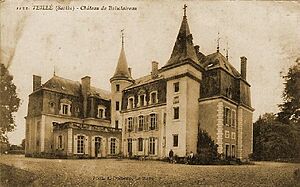Sarthe facts for kids
Quick facts for kids
Sarthe
|
|||
|---|---|---|---|

Prefecture building of the Sarthe department, in Le Mans
|
|||
|
|||

Location of Sarthe in France
|
|||
| Country | France | ||
| Region | Pays de la Loire | ||
| Prefecture | Le Mans | ||
| Subprefectures | La Flèche Mamers |
||
| Area | |||
| • Total | 6,206 km2 (2,396 sq mi) | ||
| Population
(2016)
|
|||
| • Total | 567,561 | ||
| • Rank | 46th | ||
| • Density | 91.454/km2 (236.864/sq mi) | ||
| Time zone | UTC+1 (CET) | ||
| • Summer (DST) | UTC+2 (CEST) | ||
| Department number | 72 | ||
| Arrondissements | 3 | ||
| Cantons | 21 | ||
| Communes | 354 | ||
| French Land Register data, which exclude estuaries, and lakes, ponds, and glaciers larger than 1 km2 | |||
Sarthe is a special region in France. It's called a "department." It's part of the Pays de la Loire area, located in the western part of France. The region gets its name from the Sarthe River. This river flows from east of Le Mans all the way to just north of Angers.
Contents
A Look Back: History of Sarthe
How Sarthe Became a Department
In the late 1700s, rich families built big houses and castles in this area. They used them as getaways from the busy city of Paris.
The Sarthe department was officially created during the French Revolution. This happened on March 4, 1790. It was formed from a part of an older area called Maine. Maine was then split into two departments: Sarthe in the east and Mayenne in the west.
Ancient Roots of Sarthe
Long ago, during Roman times, the city of Mans was in this area. You can still see many Roman ruins today. The Roman Thermal Bathhouse is a popular spot for visitors. So is the Theater of Aubigné-Racan. Both are near the edges of Anjou, Maine, and Touraine.
A very important scientist from the early 1600s, Marin Mersenne, was born near Sarthe.
Exploring the Geography of Sarthe
Where is Sarthe Located?
The Sarthe department is in the northern part of the Pays de la Loire region of France. It is south of Normandy. It's also on the southern edge of the Armorican Massif, which is a group of old mountains.
Sarthe shares its borders with several other departments. These include Orne, Eure-et-Loir, Loir-et-Cher, Indre-et-Loire, Maine-et-Loire, and Mayenne.
City Life and Countryside
About 300,000 people live in Le Mans, the main city in Sarthe. This is more than half of the department's total population. These people live in the city itself or in the towns very close by.
The rest of the department is mostly rural. This means it's like the countryside. Farming is the main part of the economy in these areas.
Travel and Transport in Sarthe
The arrival of trains in 1854 helped the local economy grow a lot. It made trade easier. Later, in 1989, a TGV (high-speed train) connection was built. This made it much faster to travel to and from Sarthe.
For road travel, the A11 autoroute is very important. This highway was built to Le Mans from the east in 1978. It makes Sarthe a key entry point to western France.
Images for kids
-
Stained glass in Le Mans Cathedral
-
The 24 Hours of Le Mans is the world's oldest continuing sports car race in endurance racing.
-
Church of La Ferté-Bernard
See also
 In Spanish: Sarthe para niños
In Spanish: Sarthe para niños










